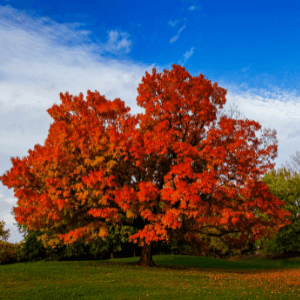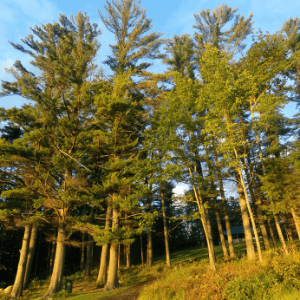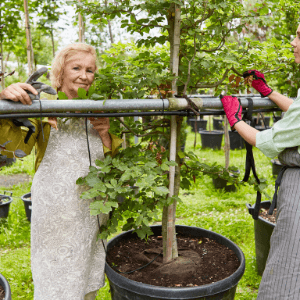Ready for fall tree planting in St. Catharines, ON? Consider the tree's hardiness, growth rate, and foliage. You will also want to select a tree appropriate for your landscape's size and climate.
Here are the best trees to plant this fall and winter:
1. Sugar Maple
Sugar maples (Acer saccharum) (hard maples and rock maples) are among our largest and finest forest trees. It can reach a height of 80 feet and a diameter of two or more.
The tree has a dense, round, and compact crown when grown in the open. It is used a lot as a shade and ornamental tree. In the fall, the leaves’ yellow, red, and crimson colours form a very showy and beautiful part of the landscape.
When choosing trees for fall planting, consider the tree's hardiness, growth rate, and foliage. You will also want to select a tree appropriate for your landscape's size and climate.
2. American Beech
It is common to find American beech trees in eastern North American forests, including those in Kentucky. In the early spring, new leaves sprout from their buds in the form of delicate tassels.
The beautiful fall foliage takes on a golden bronze hue. The American beech tree has a spreading, slender form that is more attractive than any other beech tree and is available all year.
The long, thin, pointed, brown leaf buds and the smooth, delicate, light grey "wrinkled" bark of this tree, which resembles an elephant's hide, are more prominent in the winter.
The bark of an American beech is significantly lighter in colour, approaching white, than a European beech's. Beech, like oak, generally keeps its lower leaves on into the winter.
3. White Oak
The white oak, or Quercus alba, is one of the best-known hardwood trees in eastern and central North America. It is a long-lived oak that grows in northern Florida, eastern Texas, southern Maine, Ontario, and Minnesota. It is native to eastern and central North America.
4. Red Maple
Because of its vivid red fall leaves, twigs, fruit, and flowers, the red maple earned its name. In the fall, people who go to the eastern deciduous forest praise the red maple for its bright red leaves.
Few people know that red maple trees' fall foliage can also change to yellow or orange. Red maples grow quickly and usually reach heights of between 18 and 27 metres (60 and 90 feet).
The tallest of them can reach heights of more than 120 feet (36.5
5. Norway Spruce
Fast-growing and evergreen, the Norway spruce can grow to a height of 40 metres and have a lifespan of up to 1,000 years. They have a triangular look, are tall and straight, and have a pointed crown.
Young bark has a coppery grey-brown appearance and feels smooth with rough, papery scales.
6. Eastern White Pine
Eastern white pine has soft, thin needles grouped into five bundles. Seedlings, saplings, and full-grown trees all make whorls of branches. The number of whorls along a tree's bole is a good indicator of the tree's age (in years).
Many older white pine trees have two or more leaders, which are encouraged to grow when the white pine weevil attacks the central shoot. This tree grows practically everywhere. It grows quickly in both dry and wet soils.
Its soft wood is incredibly advantageous for building.
7. Douglas Fir
The Douglas fir is an evergreen conifer that can reach a height of 55 metres and live for over 1,000 years. The bark of young trees is grey-green with highly fragrant blisters and becomes purple-brown, thick, and corky with horizontal fissures over time.
8. Hemlock
The eastern hemlock (Tsuga canadensis) is a tree native to the eastern United States. It is a popular landscaping tree in areas suitable for its majestic form.
It can be readily pruned or sheared and is as comfortable standing alone, in a group, or as a part of a hedge.
Although it can reach 100 feet or more, eastern hemlock typically grows between 40 and 7 feet tall.
Thanks to its lovely leaves, form, durability, and endurance, it's one of the most beautiful American conifers.
9. White Birch
Because the White Birch Tree (genus Betula) is deciduous, its leaves fall off each year. They have rapid growth and brief lifespans. The White Birch prefers to live in more excellent highland areas because it doesn't like being wet or hot.
It may grow in various soil types but prefers deeper, well-drained soils. The tree's rapid growth rate makes it helpful in repopulating fire-devastated areas.
There you have it: our picks for the best trees for a tree planting project in St Catharines ON.
FAQs
1. How do I care for my trees after fall planting?
After fall planting, you will need to water your trees regularly and fertilise them in the spring. You should also mulch around your trees to help keep their roots moist and protected. Additionally, you will need to prune your trees to maintain their shape and size.
2. What are some common problems with fall-planted trees?
Some common problems with fall-planted trees include root rot, drought stress, and pest infestation. Regular maintenance and care will most likely keep these issues at bay.
3. What are some benefits of fall planting?
Some benefits of planting in the fall are better root growth, more soil water, and less tree stress. Fall is also an excellent time to plant trees because the weather is more relaxed, and there is less chance of drought.
Choosing the Most Qualified Landscaper in St. Catharines, ON, to Provide Fall Landscaping Services
When choosing a landscaper in St. Catharines, ON, to provide fall landscaping services, you want to make sure that you choose someone experienced and qualified.
Here are some tips for selecting the most promising landscaper in St. Catharines, ON, to do fall landscaping work for you:
1. Ask for referrals.
Talk to your friends, family, and neighbours and see if they have any recommendations for a good landscaper in St. Catharines, ON.
2. Research online.
Read online reviews of different landscapers in St. Catharines, ON, to get an idea of their quality of work and customer service.
3. Make sure the landscaper is licensed and insured.
This will protect you in case of any accidents or damage during the project.
4. Ask to see examples of their work.
This can help you determine if the landscaper is a good fit for your needs and vision.
5. Get a written estimate.
Before hiring a landscaper, ensure you get an estimate of how much the whole project will cost.
By following these tips, you can be sure that you will find the most qualified landscaper in St. Catharines, Ontario, to provide fall landscaping services.
Check Out Landscaping St. Catharines
Landscaping St. Catharines in On can help with tree planting and all of your fall landscaping needs. Contact us today for a free consultation!
When it comes to fall landscaping, you want to choose a company that is experienced and qualified. Landscaping St. Catharines has been providing fall landscaping services for over ten years.
We are licenced and insured and offer a 100% satisfaction guarantee on all our work. Contact us today for a free consultation.




